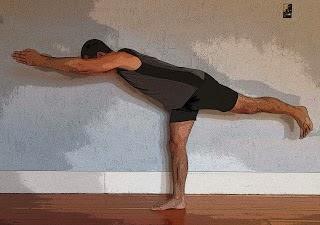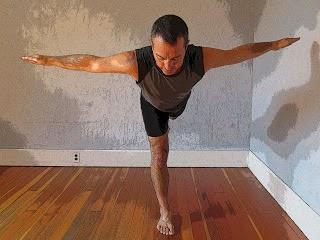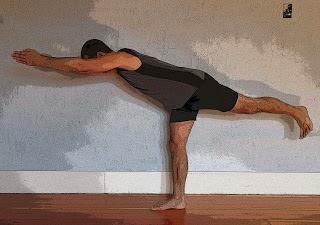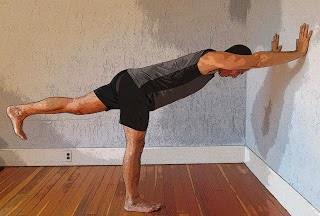 A funny thing happened a few weeks back as I watched my teacher trainees teaching one another: I saw things happening in their bodies that I miss when I am the one teaching. That is the benefit of sometimes just watching what’s happening around you! And the most interesting thing I noticed was what happened to the standing leg and knee when one of them was teaching Warrior 3 to the others. I am fond of Warrior 3, and often also frustrated by it, too. It requires balance, strength and flexibility in different parts of your body. Your standing leg hamstring has to be flexible enough to straighten at the knee while your pelvis, top leg and torso all tip over it. Your back body muscles have to be strong enough to keep your top leg, torso and sometimes arms all in one long line parallel with the floor resisting the pull of gravity. Your shoulders have to be flexible enough to take the arms overhead for the full expression of the pose. And those are just the most obvious things going on!
A funny thing happened a few weeks back as I watched my teacher trainees teaching one another: I saw things happening in their bodies that I miss when I am the one teaching. That is the benefit of sometimes just watching what’s happening around you! And the most interesting thing I noticed was what happened to the standing leg and knee when one of them was teaching Warrior 3 to the others. I am fond of Warrior 3, and often also frustrated by it, too. It requires balance, strength and flexibility in different parts of your body. Your standing leg hamstring has to be flexible enough to straighten at the knee while your pelvis, top leg and torso all tip over it. Your back body muscles have to be strong enough to keep your top leg, torso and sometimes arms all in one long line parallel with the floor resisting the pull of gravity. Your shoulders have to be flexible enough to take the arms overhead for the full expression of the pose. And those are just the most obvious things going on!What I saw that day relates to the alignment of the standing leg knee joint and is most relevant to you practitioners out there who know you are prone to hyperextension of the knee joint. Hyperextension of the knee joint means that your knee joint has a slightly greater range of motion in extension than the average person does. In other words, in people with hyperextension of the knees, when the knee is straight, instead of the femur bone on top and the shinbones on bottom forming one straight line, your knee joint bows slightly backwards.
Nina Hyperextending Her Knees
There is some controversy as to whether this is a problem in the long run. On the one hand, it likely allows those of you out there with this kind of knee joint the ability to do many of the more challenging yoga poses where the legs are straight. God knows I could use a bit of that openness in Standing Forward Bend (Uttanasana)! But there is some concern that it could lead to uneven strain on the supporting structures of the knee and could also lead to uneven wear and tear on the cushioning cartilage of your knee joint, both of which could result in dysfunction and pain down the road. So, it may be worthwhile to minimize hyperextension in the knees when possible!What I noticed that fortunate day was the following: When the students did the Warrior 3 variation in which the legs and torso are parallel with the floor and the arms are out to the sides of the body at a 45 degree angle, the standing leg was very vertical and I did not observe much hyperextension in the 8 or 9 students who normally exhibit this tendency in some of their standing poses.


You may be asking yourself what to do with this new information? If you are a stiff practitioner like me, you won’t need to do anything with it personally, unless you teach. Then I’d suggest you confirm this observation for yourself in some of your students. But if you have flexible knees yourself, you might observe your Warrior 3 from a side view in a mirror or have a trusted friend or teacher watch you in each Warrior 3 variation and see what happens in your knees.
If you do note a significant increase in hyperextension in the full pose, you might skip it (doing only the version with arms out to the side) or do it less frequently. Alternatively, check with your yoga teacher to see if he or she has techniques that you can use the bring your standing leg in full Warrior 3 into a healthier alignment. If so, try using those techniques to adjust the alignment of your standing leg in Warrior 3 both in class and when you practice at home. After all, this is a modern yoga pose, and in my book that means you can modify and adapt it to suit your unique needs. I hope this information is useful in the ever-changing exploration of your yoga practice.
Cautions: If you have low back pain, you may have to drop your lifted leg a bit lower or bend your back knee to reduce the weight stress this pose puts on your lower back (even a micro-bend to the lifted leg can be helpful). If you have arthritis of the neck, you may want to avoid lifting your head to face forward. As always, use common sense. It if hurts to do the pose, come out and ask your teacher for some feedback about what you’ve been doing. If balancing is a big problem and you’re just getting frustrated, return to the wall version.

Subscribe to YOGA FOR HEALTHY AGING by Email ° Follow Yoga for Healthy Aging on Facebook


